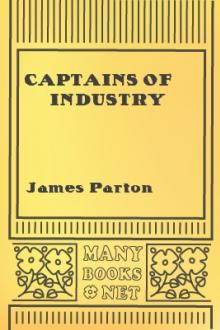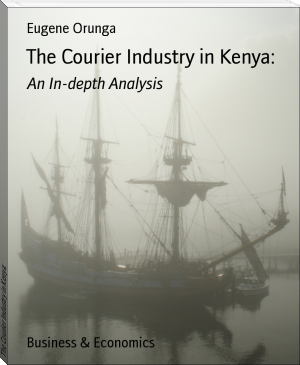Captains of Industry by James Parton (life changing books to read TXT) 📕

- Author: James Parton
- Performer: -
Book online «Captains of Industry by James Parton (life changing books to read TXT) 📕». Author James Parton
Doubtless, the remarkable longevity of Sir Moses had something to do with emphasizing the celebration. Great wealth, too, attracts the regard of mankind. But there are many rich old Jews in the world whose birthday excites no enthusiasm. The briefest review of the long life of Sir Moses Montefiore will sufficiently explain the almost universal recognition of the recent anniversary.
He was born as long ago as 1784, the second year of American independence, when William Pitt was prime minister of England. He was five years old when the Bastille was stormed, and thirty-one when the battle of Waterloo was fought. He was in middle life before England had become wise enough to make Jew and Christian equal before the law, and thus attract to her shores one of the most gifted and one of the most virtuous of races.
The father of Sir Moses lived and died in one of the narrow old streets near the centre of London called Philpot Lane, where he became the father of an old-fashioned family of seventeen children. This prolific parent was a man of no great wealth, and consequently his eldest son, Moses, left school at an early age, and was apprenticed to a London firm of provision dealers. He was a singularly handsome young man, of agreeable manners and most engaging disposition, circumstances which led to his entering the Stock Exchange. This was at a time when only twelve Jewish brokers were allowed to carry on business in London, and he was one of the twelve.
At the age of twenty-eight he had fully entered upon his career, a broker and a married man, his wife the daughter of Levy Cohen, a rich and highly cultivated Jewish merchant. His wife's sister had married N. M. Rothschild, and one of his brothers married Rothschild's sister. United thus by marriage to the great banker, he became also his partner in business, and this at a time when the gains of the Rothschilds were greatest and most rapid.
Most readers remember how the Rothschilds made their prodigious profits during the last years of Bonaparte's reign. They had a pigeon express at Dover, by means of which they obtained the first correct news from the continent. During the "Hundred Days," for example, such a panic prevailed in England that government bonds were greatly depressed. The first rumors from Waterloo were of defeat and disaster, which again reduced consols to a panic price. The Rothschilds, notified of the victory a few hours sooner than the government itself, bought largely of securities which, in twenty-four hours, almost doubled in value. Moses Montefiore, sharing in these transactions, found himself at forty-five a millionaire.
Instead of slaving away in business to the end of his life, adding million to million, with the risk of losing all at last, he took the wise resolution of retiring from business and devoting the rest of his life to works of philanthropy.
When Queen Victoria came to the throne in 1837, Moses Montefiore was sheriff of London. The queen had lived near his country-house, and had often as a little girl strolled about his park. She now enjoyed the satisfaction of conferring upon her neighbor the honor of knighthood, and a few years later she made him a baronet. Thus he became Sir Moses, which has an odd sound to us, but which in England seems natural enough.
During the last fifty years Sir Moses has been, as it were, a professional philanthropist. Every good cause has shared his bounty, but he has been most generous to poor members of his own race and religion. He has visited seven times the Holy Land, where the Jews have been for ages impoverished and degraded. He has directed his particular attention to improving the agriculture of Palestine, once so fertile and productive, and inducing the Jews to return to the cultivation of the soil. In that country he himself caused to be planted an immense garden, in which there are nine hundred fruit trees, made productive by irrigation. He has promoted the system of irrigation by building aqueducts, digging wells, and providing improved apparatus. He has also endowed hospitals and almshouses in that country.
In whatever part of the world, during the last fifty years, the Jews have been persecuted or distressed, he has put forth the most efficient exertions for their relief, often going himself to distant countries to convey the requisite assistance. When he was ninety-one years of age he went to Palestine upon an errand of benevolence. He has pleaded the cause of his persecuted brethren before the Emperor of Russia, and pleaded it with success. To all that part of the world known to us chiefly through the Jews he has been a constant and most munificent benefactor during the last half century, while never turning a deaf ear to the cry of want nearer home.
In October he completes his hundredth year. At present (January, 1884), he reads without spectacles, hears well, stands nearly erect, although six feet three in height, and has nothing of the somnolence of old age. He drives out every day, gets up at eleven, and goes to bed at nine. His diet is chiefly milk and old port wine, with occasionally a little soup or bread and butter. He still enjoys the delights of beneficence, which are among the keenest known to mortals, and pleases himself this year by giving checks of ninety-nine pounds to benevolent objects, a pound for each year that he has had the happiness of living.
MARQUIS OF WORCESTER, INVENTOR OF THE STEAM-ENGINE.In the English county of Monmouthshire, near Wales, a region of coal mines and iron works, there are the ruins of Raglan Castle, about a mile from a village of the same name. To these ruins let pilgrims repair who delight to visit places where great things began; for here once dwelt the Marquis of Worcester, who first made steam work for men. The same family still owns the site; as indeed it does the greater part of the county; the head of the family being now styled the Duke of Beaufort. The late Lord Raglan, commander of the English forces in the Crimea, belonged to this house, and showed excellent taste in selecting for his title a name so interesting. Perhaps, however, he never thought of the old tower of Raglan Castle, which is still marked and indented where the second Marquis of Worcester set up his steam-engine two hundred and twenty years ago. Very likely he had in mind the time when the first marquis held the castle for Charles I. against the Roundheads, and baffled them for two months, though he was then eighty-five years of age. It was the son of that valiant and tough old warrior who put steam into harness, and defaced his ancestral tower with a ponderous and imperfect engine.
For many centuries before his time something had been known of the power of steam; and the Egyptians, a century or more before Christ, had even made certain steam toys, which we find described in a manuscript written about 120 b. c., at Alexandria, by a learned compiler and inventor named Hero. One of these was in the form of a man pouring from a cup a libation to the gods. The figure stood upon an altar, and it was connected by a pipe with a kettle of water underneath. On lighting a fire under the kettle, the water was forced up through the figure, and flowed out of the cup upon the altar. Another toy was a revolving copper globe, which was kept in motion by the escape of steam from two little pipes bent in the same direction. Of this contrivance the French Professor Arago once wrote:—
"This was, beyond doubt, a machine in which steam engendered motion, and could produce mechanical effects. It was a veritable steam-engine! Let us hasten, however, to add that it bears no resemblance, either by its form or in mode of action, to steam-engines now in use."
Other steam devices are described by Hero. By one a horn was blown, and by another figures were made to dance upon an altar. But there is no trace in the ancient world of the application of steam to an important useful purpose. Professor Thurston of Hoboken, in his excellent work upon the "History of the Steam-Engine," has gleaned from the literature of the last seven hundred years several interesting allusions to the nature and power of steam. In 1125 there was, it appears, at Rheims in France, some sort of contrivance for blowing a church organ by the aid of steam. There is an allusion, also, in a French sermon of 1571, to the awful power in volcanic eruptions of a small quantity of confined steam. There are traces of steam being made to turn a spit upon which meat was roasted. An early French writer mentions the experiment of exploding a bomb-shell nearly filled with water by putting it into a fire. In 1630 King Charles the First of England granted to David Ramseye a patent for nine different contrivances, among which were the following:—
"To raise water from low pits by fire. To make any sort of mills to go on standing waters by continual motion without help of wind, water, or horse. To make boats, ships, and barges to go against strong wind and tide. To raise water from mines and coal pits by a way never yet in use."
This was in 1630, which was about the date of the Marquis of Worcester's engine. It is possible, however, that these devices existed only in the imagination of the inventor. The marquis was then twenty-nine years of age, and as he was curious in matters of science, it is highly probable that he was acquainted with this patent, and may have conversed with the inventor.
It is strange how little we know of a man so important as the Marquis of Worcester in our modern industrial development. I believe that not one of the histories of England mentions him, and scarcely anything is known of the circumstances that led to his experimenting with steam. Living in a county of coal and iron mines, and his own property consisting very much in coal lands, his attention must of necessity have been called to the difficulties experienced by the miners in pumping the water from the deep mines. There were mines which employed as many as five hundred horses in pumping out the water, and it was a thing of frequent occurrence for a productive mine to be abandoned because the whole revenue was absorbed in clearing it of water. This inventor was perhaps the man in England who had the greatest interest in the contrivance to which in early life he turned





Comments (0)